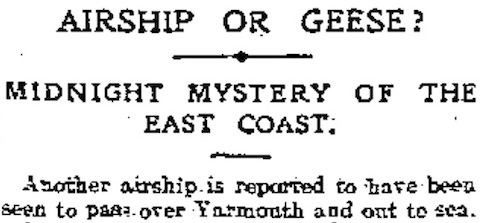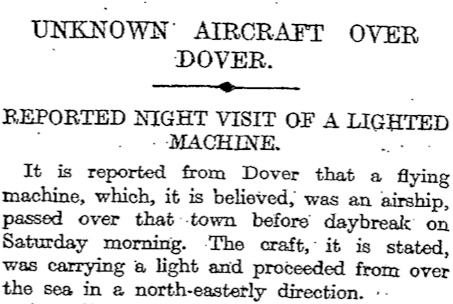
The Daily Express today features, p. 6, an article with the title 'Air ships and scare ships', written by C. G. Grey, editor of The Aeroplane. Grey has been given a full column immediately following the leading articles to make his case that whatever else they may be, the phantom airships are good news. He begins by briefly noting the various 'weird nocturnal sightings in the sky' to date: 'That little trip of the Zeppelin's over Sheerness started it', followed by 'Strange lights and noises over the Firth of Forth', 'the Bristol Channel' and 'along the east coast'. Then 'One of our own tiny airboatlets' was seen at Portsmouth (a reference to an unexpected visit by the Army airship Beta II in December), and now the Dover incident. Grey thinks that 'quite possibly [...] the same vessel' was responsible for all of these sightings, though he does think the report that 'the machine at Dover' (perhaps he means the Bristol Channel) 'carried an acetylene searchlight is probably the result of a vivid imagination, for one does not play with an acetylene flame in the immediate neighbourhood of some thousands of cubic feet of highly inflammable gas'. A fair point, really.
But Grey is not here to debate the reality of the phantom airships, or whether or not they pose any sort of a threat. He is quite explicit about his interest here:
Not for a moment would I deny the possibility of these celestial manifestations being outward and visible signs of foreign and most unheavenly airships. The more foreign vessels that come over here and act as scare-ships, the better for this country, for not until the average Englishman has been thoroughly scared into realising that we are no longer the 'right little tight little island' of the Jingo poets will there be any hope of putting our aerial defence forces on a proper footing.
The situation is dire: 'for practical purposes in time of war, the Royal Flying Corps, which is nearly a year old, does not exist'.
The 'Airship and Kite Squadron' has not a single airship which could not be put out of action in ten minutes by the pilot of any aeroplane of medium speed. Of the three aeroplane squadrons, which the Secretary of State for War recently stated had been formed, not one is capable of forming an effective unit with an army in the field.
The RFC possesses about half a dozen 'really fast machines' but these are useless because there are no motor transports or mobile workshops to support them on deployment. Moreover, 'only three or four of our "flying officers" have ever flown really fast aeroplanes', and 'In certain cases our very best military fliers have been deliberately prevented from flying' -- perhaps for fear of negative publicity from fatal crashes, or perhaps there just aren't enough effective machines to risk losing any. Grey contrasts the French army with the British: the former had 218 aeroplanes at the start of 1912 and has since bought more than 400 'new and up-to-date aeroplanes'; whereas it was recently announced that 'the military wing of the Royal Flying Corps had then fourteen biplanes in use, and sixteen on order'.
The position is briefly this: We have not a tenth enough trained pilots nor a twentieth of the proper number of aeroplanes. Without machines we cannot have the pilots. Without trained workmen we cannot have the machines. Without regular employment we cannot have the right class of workmen to build aeroplanes -- a class of work which is a thing apart. Without regular Government orders our aeroplane manufacturers cannot give regular employment. Without money the Government officials cannot give out regular orders. Without the pressure of public opinion the Treasury either cannot, or will not, grant enough money to buy aeroplanes. And without being thoroughly scared, the great British public will not bring pressure to bear on the Treasury, through its various representatives in the House of Commons. Therefore, the more scare-ships which visit our shores, the better chance there will be of moving the English mind and getting something done.
A remarkably candid justification for scaremongering.
But to return to those scareships. Grey has some new evidence to support his firm belief that the Sheerness one, at the very least, was definitely a Zeppelin. After noting that its 'visit has been officially admitted by the Admiralty, and has never been officially denied by the Germans', he goes on to say that 'certain friends of mine in Germany tell me that among aeronautical people in that country the trip is a recognised fact'. Even more convincingly:
Also -- and this evidence has not been made public before -- a French naval aviator told a French civilian aviator of my acquaintance, only a few days ago, that on the afternoon of the Sheerness visit [14 October 1912] he was on board a torpedo-boat in the North Sea off the Belgian coast, when a Zeppelin dirigible passed over them at 1,000 feet or so, heading for the British coast. So we can rest assured that the visit was really made by a German airship.
And if Grey's acquaintance's acquaintance isn't authoritative enough, the following paragraph appears in The Times, p. 6:
THE AIRSHIP MYSTERY
There is reason to believe that the mysterious airship which visited Sheerness at night, and more recently Dover, is the Hansa, a Zeppelin airship which is not in the possession of the German Government.
The Liverpool Echo is evidently so impressed by this revelation that it has decided to live up to its name and print it twice (p. 3, p. 5).
Finally, the Freeman's Journal (Dublin) has a short report on the airship seen at Newport last Wednesday, much less detailed than and in places differing from the one which appeared in the Irish Times:
On Wednesday [8 January 1913] evening, about 7.30 o'clock, several people in Newport, about six miles from Westport, observed what to all appearances was an airship passing over the town, and coming from an easterly direction. It carried a remarkably brilliant head-light, which lit up its surroundings for a distance of about 200 yards. Having come over the town, the airship headed towards the sea, but it had not gone far when it changed its course and flew in the direction of Westport, and was seen by several people. All the local police stations were communicated with by wire from Newport, but nothing further was observed of the mysterious machine.
The Irish Times said the airship was first seen at 6.40pm, nearly an hour earlier; but more importantly in that account it never flew over Newport as it was believed to be struggling towards it against the wind. The detail about the airship lighting up its surroundings is also new. Westport is south of Newport, whereas the Irish Times said it disappeared to the southwest. However, the suggestion that the airship was also seen at Westport perhaps suggests that new information had come to light since the Irish Times report, possibly in a local newspaper, so the version given by the Freeman's Journal probably shouldn't be ruled out entirely.
![]() This work is licensed under a Creative Commons Attribution-NonCommercial-NoDerivatives 4.0 International License.
Permissions beyond the scope of this license may be available at http://airminded.org/copyright/.
This work is licensed under a Creative Commons Attribution-NonCommercial-NoDerivatives 4.0 International License.
Permissions beyond the scope of this license may be available at http://airminded.org/copyright/.





Brett Holman
Post authorI've found (by way of Historic Wings) a reference for the 'Strange lights and noises over the Firth of Forth' mentioned by Grey, though it falls outside my post-blogging window (according to Watson, Oldroyd and Clarke, who transcribe the letter published in the Evening Dispatch, the sighting itself would have been on 2 November 1912). Oiseau Bleu in the 'Eddies' column in Flight, 23 November 1912, 1087:
(Compare with Oiseau Bleu's more sceptical take on phantoms airships a couple of months later.) One interesting thing about this is that while it was not reported until three weeks after the Sheerness Incident (i.e. on 5 November 1912), the Sheerness Incident itself did not reach the press until mid-November. So unless the author of the letter (who gave only their initials, J. L. B.) had inside information the Firth of Forth sighting was not influenced in any way by the Sheerness one.
Pingback:
Thursday, 30 January 1913
Pingback:
Wednesday, 22 January 1913
Pingback:
Sunday, 2 March 1913